Abstract
The postural sway responses of 63 children with a mean age of 5.74 years were quantified with a Force Platform technique. The average maximum (max) blood lead (PbB) of these children during the first 5 years of life was 20.7 micrograms/dL (range 9.2 to 32.5). The backward stepwise regression analysis for sway area response during the eyes-closed, no-foam test with all the covariates and confounders and the PbB parameters showed a significant relationship with peak or max PbB during the second year of life. These results are consistent with our previous study with a smaller group of children. The data have been analyzed to provide some insight into the role of various afferent for the maintenance of postural balance. The results suggests a hypothesis that if the max PbB had caused some level of impairment in the functional capacities or interconnectivity of the vestibular and/or proprioception systems at 2 years of age, then it is reasonable to assume that the redundancy in the postural afferent systems would naturally adapt to rely more on the remaining intact afferent system (in this case, vision).
Full text
PDF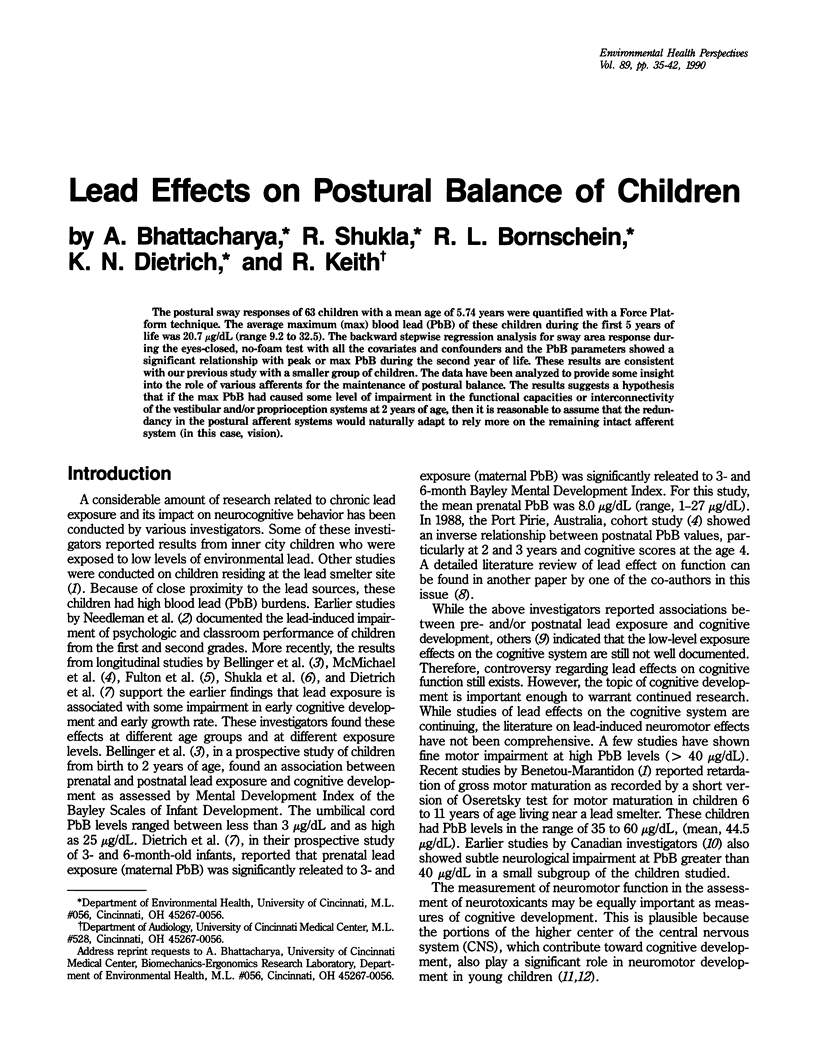

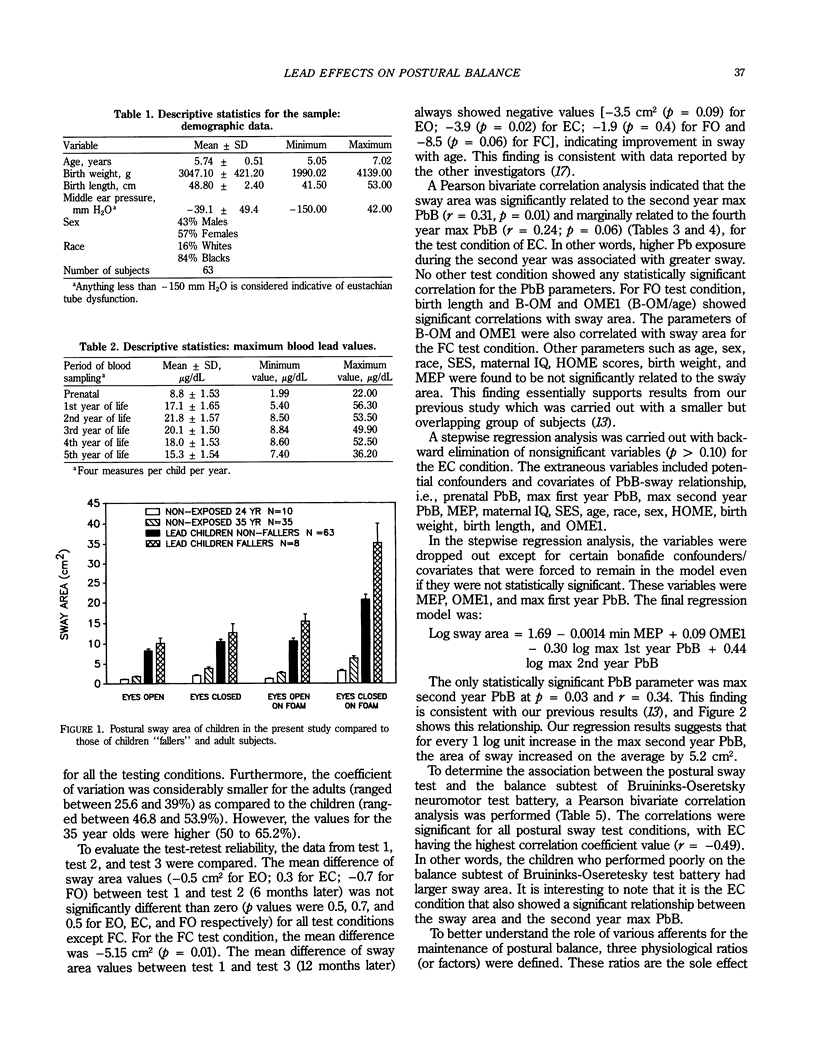
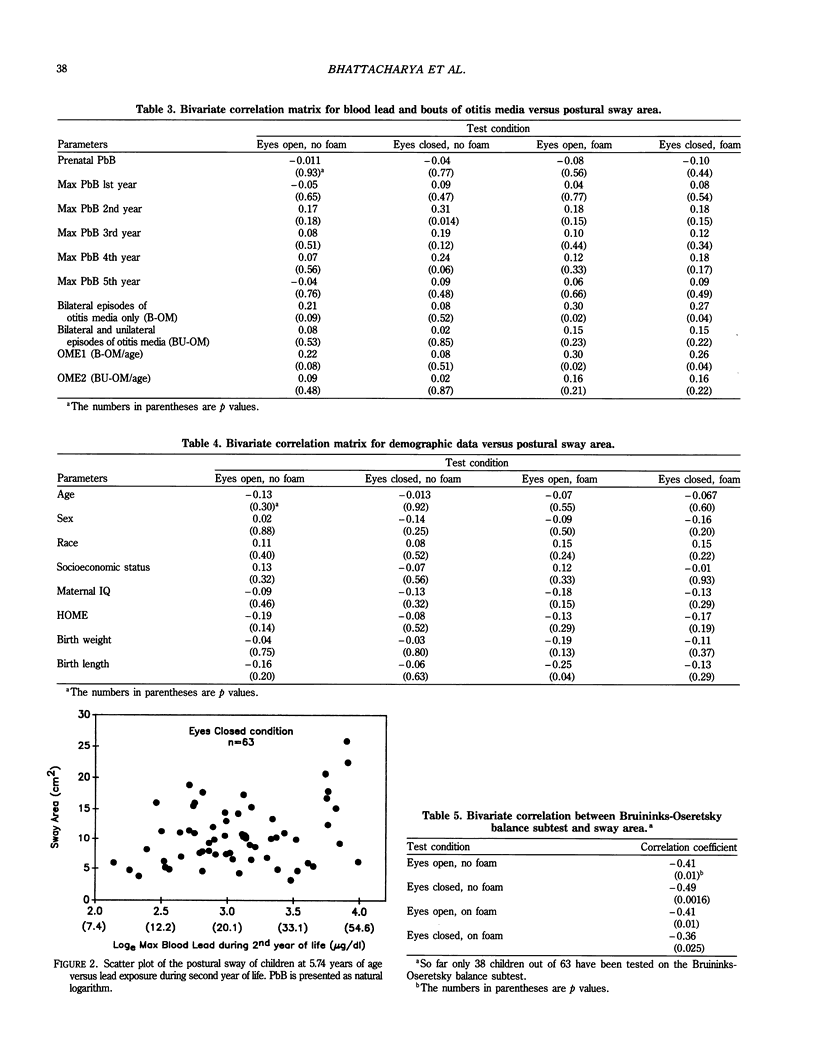
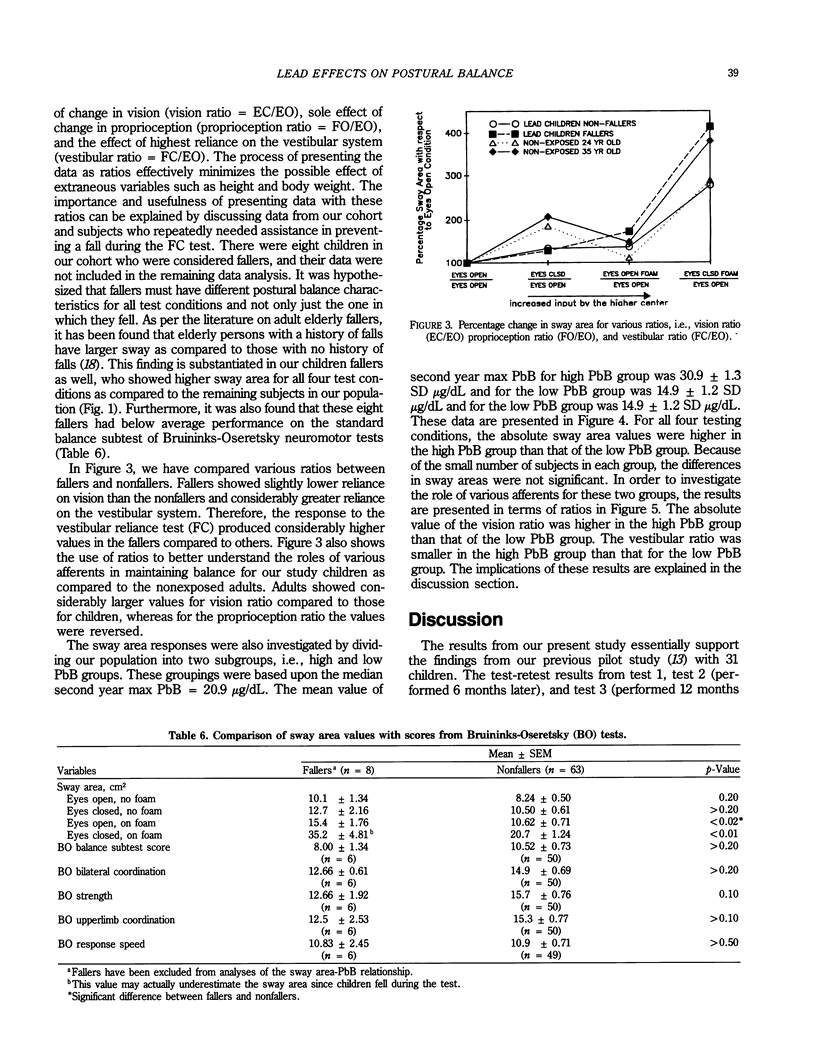

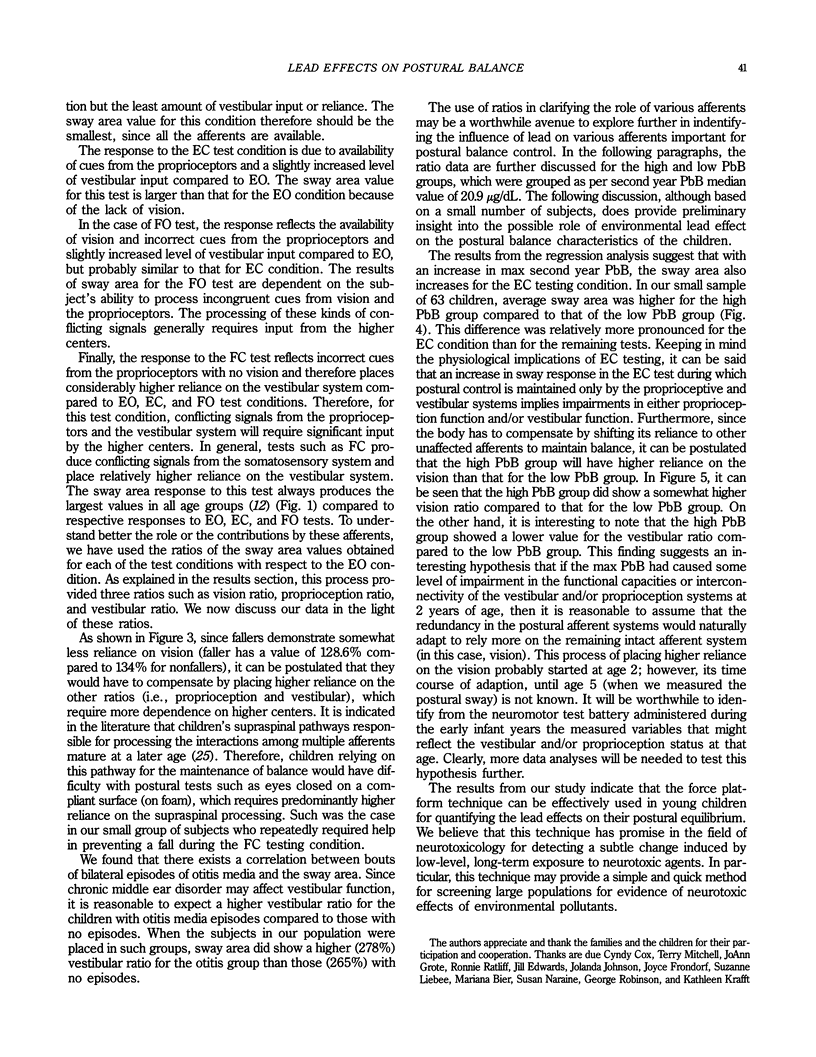
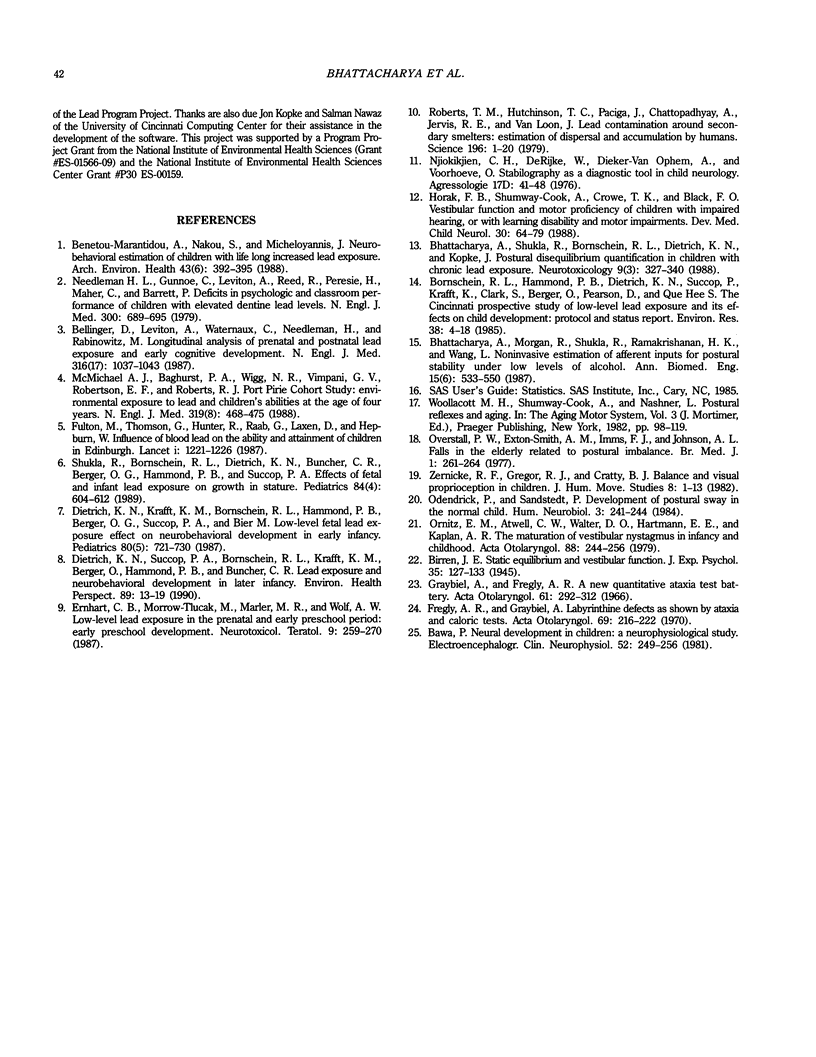
Selected References
These references are in PubMed. This may not be the complete list of references from this article.
- Bawa P. Neural development in children: a neurophysiological study. Electroencephalogr Clin Neurophysiol. 1981 Oct;52(4):249–256. doi: 10.1016/0013-4694(81)90054-7. [DOI] [PubMed] [Google Scholar]
- Bellinger D., Leviton A., Waternaux C., Needleman H., Rabinowitz M. Longitudinal analyses of prenatal and postnatal lead exposure and early cognitive development. N Engl J Med. 1987 Apr 23;316(17):1037–1043. doi: 10.1056/NEJM198704233161701. [DOI] [PubMed] [Google Scholar]
- Benetou-Marantidou A., Nakou S., Micheloyannis J. Neurobehavioral estimation of children with life-long increased lead exposure. Arch Environ Health. 1988 Nov-Dec;43(6):392–395. doi: 10.1080/00039896.1988.9935856. [DOI] [PubMed] [Google Scholar]
- Bhattacharya A., Morgan R., Shukla R., Ramakrishanan H. K., Wang L. Non-invasive estimation of afferent inputs for postural stability under low levels of alcohol. Ann Biomed Eng. 1987;15(6):533–550. doi: 10.1007/BF02364247. [DOI] [PubMed] [Google Scholar]
- Bhattacharya A., Shukla R., Bornschein R., Dietrich K., Kopke J. E. Postural disequilibrium quantification in children with chronic lead exposure: a pilot study. Neurotoxicology. 1988 Fall;9(3):327–340. [PubMed] [Google Scholar]
- Bornschein R. L., Hammond P. B., Dietrich K. N., Succop P., Krafft K., Clark S., Berger O., Pearson D., Que Hee S. The Cincinnati prospective study of low-level lead exposure and its effects on child development: protocol and status report. Environ Res. 1985 Oct;38(1):4–18. doi: 10.1016/0013-9351(85)90067-2. [DOI] [PubMed] [Google Scholar]
- Dietrich K. N., Krafft K. M., Bornschein R. L., Hammond P. B., Berger O., Succop P. A., Bier M. Low-level fetal lead exposure effect on neurobehavioral development in early infancy. Pediatrics. 1987 Nov;80(5):721–730. [PubMed] [Google Scholar]
- Dietrich K. N., Succop P. A., Bornschein R. L., Krafft K. M., Berger O., Hammond P. B., Buncher C. R. Lead exposure and neurobehavioral development in later infancy. Environ Health Perspect. 1990 Nov;89:13–19. doi: 10.1289/ehp.908913. [DOI] [PMC free article] [PubMed] [Google Scholar]
- Ernhart C. B., Morrow-Tlucak M., Marler M. R., Wolf A. W. Low level lead exposure in the prenatal and early preschool periods: early preschool development. Neurotoxicol Teratol. 1987 May-Jun;9(3):259–270. doi: 10.1016/0892-0362(87)90011-0. [DOI] [PubMed] [Google Scholar]
- Fregly A. R., Graybiel A. Labyrinthine defects as shown by ataxia and caloric tests. Acta Otolaryngol. 1970 Mar;69(3):216–222. doi: 10.3109/00016487009123356. [DOI] [PubMed] [Google Scholar]
- Graybiel A., Fregly A. R. A new quantitative ataxia test battery. Acta Otolaryngol. 1966 Apr;61(4):292–312. [PubMed] [Google Scholar]
- Horak F. B., Shumway-Cook A., Crowe T. K., Black F. O. Vestibular function and motor proficiency of children with impaired hearing, or with learning disability and motor impairments. Dev Med Child Neurol. 1988 Feb;30(1):64–79. doi: 10.1111/j.1469-8749.1988.tb04727.x. [DOI] [PubMed] [Google Scholar]
- McMichael A. J., Baghurst P. A., Wigg N. R., Vimpani G. V., Robertson E. F., Roberts R. J. Port Pirie Cohort Study: environmental exposure to lead and children's abilities at the age of four years. N Engl J Med. 1988 Aug 25;319(8):468–475. doi: 10.1056/NEJM198808253190803. [DOI] [PubMed] [Google Scholar]
- Needleman H. L., Gunnoe C., Leviton A., Reed R., Peresie H., Maher C., Barrett P. Deficits in psychologic and classroom performance of children with elevated dentine lead levels. N Engl J Med. 1979 Mar 29;300(13):689–695. doi: 10.1056/NEJM197903293001301. [DOI] [PubMed] [Google Scholar]
- Odenrick P., Sandstedt P. Development of postural sway in the normal child. Hum Neurobiol. 1984;3(4):241–244. [PubMed] [Google Scholar]
- Ornitz E. M., Atwell C. W., Walter D. O., Hartmann E. E., Kaplan A. R. The maturation of vestibular nystagmus in infancy and childhood. Acta Otolaryngol. 1979;88(3-4):244–256. doi: 10.3109/00016487909137166. [DOI] [PubMed] [Google Scholar]
- Overstall P. W., Exton-Smith A. N., Imms F. J., Johnson A. L. Falls in the elderly related to postural imbalance. Br Med J. 1977 Jan 29;1(6056):261–264. doi: 10.1136/bmj.1.6056.261. [DOI] [PMC free article] [PubMed] [Google Scholar]
- Shukla R., Bornschein R. L., Dietrich K. N., Buncher C. R., Berger O. G., Hammond P. B., Succop P. A. Fetal and infant lead exposure: effects on growth in stature. Pediatrics. 1989 Oct;84(4):604–612. [PubMed] [Google Scholar]


